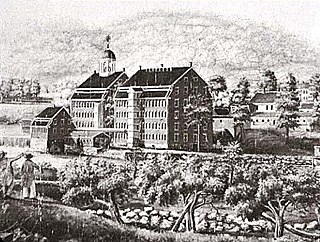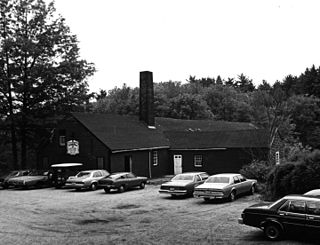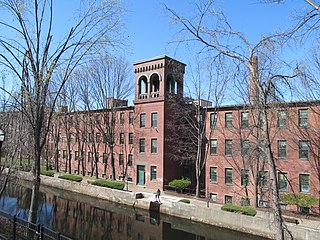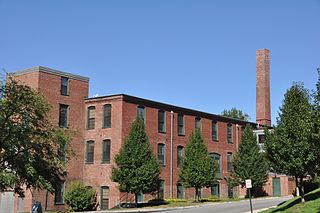Significance
Nathan Starr, Sr., a scythe manufacturer, purchased land on the West (no Coginchaug) River in Staddle Hill in 1799. Joined by his son, Nathan Jr. in 1812, Starr began the first of a long series of government contracts to produce swords, pistols, and eventually rifles. They constructed a factory here in 1812, [2] which is probably the easternmost building sited by the pond. After Nathan Sr's death in 1821, his son carried on the business until 1845. During this period some 70,000 arms of varied kinds were made here, as well as a number of commemorative swords for national heroes, such as Andrew Jackson.
From 1845 to 1864 the factory was relatively inactive. In the latter year the Russell Manufacturing Company bought the property; in 1865 they erected the building immediately to the west of the original plant in a similar height, scale, material, and style. This was an auxiliary operation, complementing the main South Farms factories; Russell conducted manufacturing here for some ninety years. A plumbing products firm and then a lighting fixture company ran short-lived manufacturing operations here; the facilities were vacant in the late 1960s. Joseph J. Vinci bought the property in 1971. Several small businesses currently operate here, including a cabinetmaker, garment shop and welding outfit.
The Starr Mill is an archetypical nineteenth century mill: a tall, many-windowed brick building beside a mill pond. There have been few major exterior alterations. Rounded-arched brownstone sluiceways (now bricked up) run beneath the building. On each end of the building three gable end chimney stacks terminate in the attic. Artifacts from former functions of the mill abound. A late 19th century turbine lines in the water near the southeastern corner of the earlier building.
This complex is a well-preserved and significant industrial site which has been successfully adapted to light manufacturing uses. The buildings are presently used for mixed use of retail, office, artist studios, professional service space and storage. The structures are well maintained.

The Mechanic Street Historic District encompasses a historic 19th-century mill and mill village in a 14-block area of the Pawcatuck section of Stonington, Connecticut. Extending along the Pawcatuck River and south of West Broad Street, the area includes a large brick mill complex on the banks of the river, and a neighborhood of well-preserved worker housing on the road grid to its west. The district was listed on the National Register of Historic Places in 1988.

The Boston Manufacturing Company was a business that operated the first factory in America. It was organized in 1813 by Francis Cabot Lowell, a wealthy Boston merchant, in partnership a group of investors known as The Boston Associates, for the manufacture of cotton textiles. It built the first integrated spinning and weaving factory in the world at Waltham, Massachusetts, using water power. They used plans for a power loom that he smuggled out of England as well as trade secrets from the earlier horse-powered Beverly Cotton Manufactory, of Beverly, Massachusetts, of 1788. This was the largest factory in the U.S., with a workforce of about 300. It was a very efficient, highly profitable mill that, with the aid of the Tariff of 1816, competed effectively with British textiles at a time when many smaller operations were being forced out of business. While the Rhode Island System that followed was famously employed by Samuel Slater, the Boston Associates improved upon it with the "Waltham System". The idea was successfully copied at Lowell, Massachusetts and elsewhere in New England. Many rural towns now had their own textile mills.

The Russell Company Upper Mill is an historic structure in Middletown, Connecticut, built in 1836 and listed on the National Register of Historic Places. The building stands at the junction of Russell Street and East Main Street in South Farms. There is a small pond to the south. East Main Street's commercial and industrial development ends there. To the north, small businesses border the street, followed by the buildings of Russell Manufacturing Company, the area's most dominant feature. Russell Street crosses Sumner Brook nearby and ascends to a large residential district to the west. The mill is currently a condo-apartment complex.

The Sanseer Mill is a historic 19th-century mill at 282 Main Street Extension in Middletown, Connecticut. It was added to the United States National Register of Historic Places in 1986.

The Wilcox, Crittenden Mill, also known as Wilcox, Crittenden Mill Historic District, is a 17-acre (6.9 ha) property in Middletown, Connecticut that was listed on the National Register of Historic Places in 1986. It was the location of the Wilcox, Crittenden company, a marine hardware firm. The historic district listing included four contributing buildings and three other contributing sites.
The 'history of Connecticut Industry is a major part of the history of Connecticut. Between the birth of the U.S. patent system in 1790 and 1930, Connecticut had more patents issued per capita than any other state; in the 19th century, when the U.S. as a whole was issued one patent per three thousand population, Connecticut inventors were issued one patent for every 700–1000 residents. Connecticut's first recorded invention was a lapidary machine, by Abel Buell of Killingworth, in 1765.

The Central Village Historic District is a historic district in the Central Village area of Plainfield, Connecticut that was listed on the National Register of Historic Places (NRHP) in 1991. It encompasses a late 19th-century historic mill village, including a small commercial center where Connecticut Route 12 and 14 meet, a cluster of architecturally distinguished buildings built by mill owners and managers, and a collection of mill worker housing units. It includes the Plainfield Woolen Company Mill, which is separately listed, as well as archaeological remnants of other mill infrastructure. It also includes Plainfield's old town hall and high school. Other architecturally prominent buildings include the c. 1855 Italianate mansion of mill owner Arthur Fenner, and the 1845 Greek Revival Congregational Church.

The Tack Factory was a historic industrial facility at 49 Tiffany Road in Norwell, Massachusetts, United States. With its oldest portion dating to 1834, it was the last surviving 19th-century mill building in Norwell prior to its destruction by fire in 1983. It was listed on the National Register of Historic Places in 1980. For most of its history it was used in the manufacture of horse tack equipment.

Ames Manufacturing Company was a manufacturer of swords, tools and cutlery in Chicopee, Massachusetts, as well as an iron and bronze foundry. They were a major provider of side arms, swords, light artillery, and heavy ordnance for the Union in the American Civil War. They also cast a number of bronze statues which can be found throughout New England.

The Walker Body Company Factory is a historic factory complex on Oak Street at River Court in Amesbury, Massachusetts. It has been converted to residential use.

The Daniel Cragin Mill, known today as the Frye's Measure Mill, is a historic watermill established in 1858. The mill is about three miles (5 km) west of the small town of Wilton in Hillsborough County, New Hampshire. For over 150 years the mill's production has been unique woodenware and wooden boxes used for dry measuring boxes. Presently the mill's main production is Shaker-style pantry boxes and furniture pieces for the various Shaker communities and their museum gift shops. The mill was added to the U.S. National Register of Historic Places in 1982.

The Plainfield Woolen Company Mill is a historic mill building on Main Street in Plainfield, Connecticut. Built in 1901, the building played a vital role in revitalizing the local economy, which was stagnating at the time. It remained the site of active textile manufacturing until 1984. The building is a visually distinctive landmark in the community, in part because of its unusual monitor roof. The building was listed on the National Register of Historic Places in 1985. It has been converted into condominia.

Hallville Mill Historic District is a historic district in the town of Preston, Connecticut, that was listed on the National Register of Historic Places in 1996. Contributing properties in the district are 23 buildings, two other contributing structures, and one other contributing site over a 50-acre (20 ha) area. The district includes the dam that forms Hallville Pond, historic manufacturing buildings and worker housing, and the Hallville Mill Bridge, a lenticular pony truss bridge built circa 1890 by the Berlin Iron Bridge Company.

The Strouse, Adler Company Corset Factory is a historic factory complex at 78-84 Olive Street in New Haven, Connecticut. Developed between 1876 and 1923, it was the largest and oldest of the city's several corset manufacturers, and remained in continuous operation for that purpose until 1998. The complex was listed on the National Register of Historic Places in 2002. It has since been converted into residential use.

The New York Belting and Packing Co. complex, also known locally for its main 20th-century occupant, the Fabric Fire Hose Company, is a historic industrial complex at 45-71, 79-89 Glen Road in Newtown, Connecticut. Its centerpiece is a four-story brick mill building with an Italianate tower, built in 1856. The property also includes a dam impounding the adjacent Pootatuck River, a mill pond, and a hydroelectric power generation facility. The site's industrial history begins about 1850, when the dam was built. The New York Belting and Packing Company built the present factory building and another further upstream, where it operated until 1917. The property was then acquired by a subsidiary of Uniroyal, which let the premises to the Fabric Fire Hose Company, its tenant until 1977.

The Coventry Glass Factory Historic District is a 32-acre (13 ha) historic district in Coventry, Connecticut that was listed on the National Register of Historic Places in 1987. The listing encompasses ten historically significant houses, clustered near the site of the former Coventry Glass Factory, in a linear district along what was the Boston Turnpike, now U.S. Route 44. The Skungamaug River is a creek cutting through the district. The glassworks operated here between 1813 and about 1845, and most of these houses date to that time, exhibiting largely vernacular Federal and Greek Revival styles. The most sophisticated and best-preserved house is that of Nathaniel Root, at 1044 Boston Turnpike. The ground in the area of the glassworks is littered with melted glass fragments and burnt brick fragments.

Eldredge Mills Archeological District is a 2.3-acre (0.93 ha) historic district in Willington, Connecticut that was listed on the National Register of Historic Places in 2000. The property is also denoted Site No. 160-15.

The Hurwood Company is a historic industrial complex at 379 Summer Street in Southington, Connecticut. Built beginning sometime before 1884, this complex of mainly brick buildings is typical of the town's industrial landscape of the late 19th and early 20th centuries, and was where solid-headed screwdrivers were first manufactured. The complex was listed on the National Register of Historic Places in 1988.

The Bigelow-Hartford Carpet Mills were once one of the largest manufacturers of carpeting in the United States. The company's early 20th-century factories, located in Thompsonville, Connecticut, were listed on the National Register of Historic Places in 1983. Used by a succession of carpet makers until the 1960s, the company complex has for the most part been converted to residential use.




















